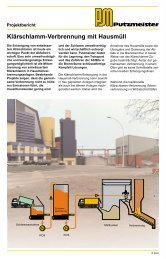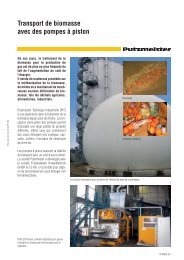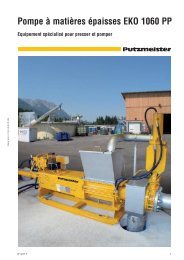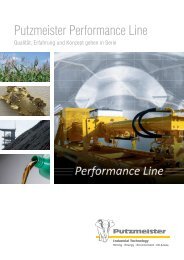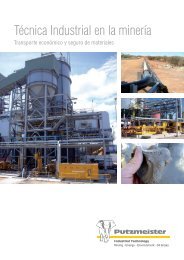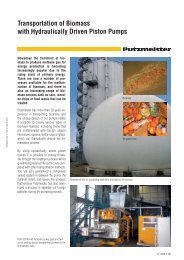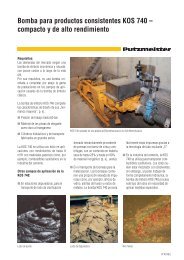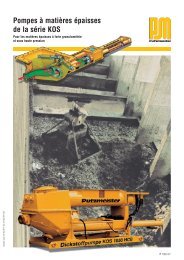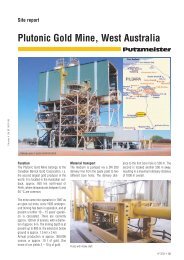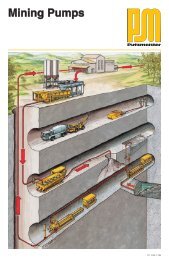Burning alternative fuels at cement plants - Putzmeister Solid Pumps
Burning alternative fuels at cement plants - Putzmeister Solid Pumps
Burning alternative fuels at cement plants - Putzmeister Solid Pumps
You also want an ePaper? Increase the reach of your titles
YUMPU automatically turns print PDFs into web optimized ePapers that Google loves.
Site report<br />
<strong>Burning</strong> <strong>altern<strong>at</strong>ive</strong> <strong>fuels</strong> <strong>at</strong> <strong>cement</strong> <strong>plants</strong><br />
Primary energies such as coal and<br />
n<strong>at</strong>ural gas are currently so<br />
expensive th<strong>at</strong> energy intensive<br />
industries are being forced to look<br />
into <strong>altern<strong>at</strong>ive</strong> <strong>fuels</strong>.<br />
<strong>Putzmeister</strong> Systems Engineering<br />
is supporting the <strong>cement</strong> industry,<br />
by providing silos and pumps to<br />
receive and supply <strong>altern<strong>at</strong>ive</strong><br />
<strong>fuels</strong>, to produce reasonably<br />
priced <strong>cement</strong> for all kind of construction<br />
works.<br />
Transporting the m<strong>at</strong>erials<br />
Altern<strong>at</strong>ive <strong>fuels</strong> must have a proven high<br />
calorific value to make a worthy repla<strong>cement</strong><br />
for primary energies.<br />
Fuels suited for this purpose are:<br />
■ mechanically dew<strong>at</strong>ered<br />
sewage sludge<br />
■ tar<br />
■ paint sludge<br />
■ and other similar m<strong>at</strong>erials,<br />
such as animal carcasses<br />
These <strong>fuels</strong> are placed in silos,<br />
either individually or mixed together.<br />
The <strong>Putzmeister</strong> high density solids<br />
pump supplies these secondary <strong>fuels</strong>,<br />
either on the cold side of the rotary kiln<br />
as additives and energy suppliers, or on<br />
the hot side as <strong>fuels</strong>.<br />
M<strong>at</strong>erials<br />
As has been mentioned, any type of<br />
m<strong>at</strong>erial with a high calorific value can be<br />
used. This is not <strong>at</strong> all affected by whether<br />
there are foreign bodies in the m<strong>at</strong>erial,<br />
since the <strong>Putzmeister</strong> S-tube tech-<br />
Sludge from coolant prepar<strong>at</strong>ion<br />
Animal carcasses (waste from slaughter house)<br />
nology is able to convey these foreign<br />
bodies even if they occupy up to 2/3 of<br />
the pipeline diameter.<br />
The secondary <strong>fuels</strong> being fed to the<br />
<strong>Putzmeister</strong> high density solids pump<br />
should be supplied in a processed form<br />
(they must be suitable for pumping).<br />
Sewage sludge<br />
Paint sludge<br />
High density solids pump<br />
with S-transfer tube – KOS<br />
Hazardous waste<br />
IP 3776-2 GB
Delivery line<br />
St<strong>at</strong>ion type 1 DN 150, PN 64<br />
St<strong>at</strong>ion type 2<br />
to the<br />
<strong>cement</strong> kiln<br />
Ultrasonic sensor<br />
Abheften unter: A 1.00, A 4.00, BP 1.03, BP 4.03<br />
Machine equipment<br />
The volume of m<strong>at</strong>erial to be fed into the<br />
<strong>cement</strong> kiln is approx. 2.7 m 3 /h. Thus<br />
<strong>Putzmeister</strong> high density solids pumps<br />
in the KOS 1040 to KOS 1050 range are<br />
used.<br />
There are three types of sludge handling<br />
st<strong>at</strong>ions.<br />
St<strong>at</strong>ion type 1<br />
The receiving st<strong>at</strong>ion consists of a high<br />
density solids pump with a precompression<br />
screw conveyor and a built in<br />
St<strong>at</strong>ion type 2<br />
The pump unit used for st<strong>at</strong>ion type 2 is<br />
identical to th<strong>at</strong> employed with st<strong>at</strong>ion<br />
type 1. The only difference is th<strong>at</strong> the<br />
<strong>at</strong>tachable hopper is replaced by a receiving<br />
silo with a volume of approx. 100<br />
m3.<br />
The benefits of this st<strong>at</strong>ion type are:<br />
■ large storage volume for the <strong>altern<strong>at</strong>ive</strong><br />
fuel. The <strong>cement</strong> kiln can now be<br />
continuously charged with <strong>altern<strong>at</strong>ive</strong><br />
fuel – even <strong>at</strong> weekends and during<br />
holidays, when there are no deliveries<br />
of repla<strong>cement</strong> fuel.<br />
■ different sludges can be fed into the<br />
high density solids pump and mixed<br />
together by the pump’s rot<strong>at</strong>e function<br />
Front wheel loader<br />
Hydraulic<br />
power unit<br />
Installed performance<br />
approx. 75 kW<br />
<strong>at</strong>tachable hopper with a volume between<br />
6 and 10 m 3 . The pump unit is charged<br />
with a front wheel loader.<br />
The benefits of this st<strong>at</strong>ion type are:<br />
Twin screw<br />
feeding device,<br />
hydr. driven<br />
KOS piston pump:<br />
S-tube type;<br />
delivery output:<br />
3 – 6 m3/h<br />
■ the pump unit is mobile, which<br />
means it can be used on more than<br />
one <strong>cement</strong> plant<br />
■ this compact unit can supply<br />
<strong>altern<strong>at</strong>ive</strong> <strong>fuels</strong> economically to the<br />
<strong>cement</strong> kiln<br />
■ a wide range of different sludges can<br />
be mixed on the spot and fed to the<br />
pump unit<br />
Foreign body<br />
separ<strong>at</strong>or<br />
Crechy Vic<strong>at</strong>, France<br />
Polymer injection system<br />
St<strong>at</strong>ion type 3<br />
Sliding frame,<br />
hydr. driven<br />
Hydraulic<br />
power unit<br />
Installed performance<br />
approx. 75 kW<br />
Silo,<br />
rectangular<br />
design<br />
The benefits of this st<strong>at</strong>ion type are:<br />
■ different <strong>altern<strong>at</strong>ive</strong> <strong>fuels</strong> can be<br />
delivered in one or more receiving<br />
bunkers. High-volume high density<br />
solids pumps convey the fuel into a<br />
storage silo of approx. 250 m 3 in<br />
volume. The receiving bunker is thus<br />
available for new deliveries of fuel.<br />
■ the <strong>altern<strong>at</strong>ive</strong> <strong>fuels</strong> mix together well<br />
in the high volume storage silo, thus<br />
guaranteeing a constant calorific<br />
value<br />
■ one or more <strong>Putzmeister</strong> high density<br />
solids pumps can be arranged under<br />
the storage silo to feed one or more<br />
<strong>cement</strong> kilns with <strong>altern<strong>at</strong>ive</strong> fuel <strong>at</strong><br />
the same time<br />
Ultrasonic sensor<br />
Silo volume<br />
approx. 100 m 3<br />
KOS piston pump:<br />
S-tube type;<br />
delivery output:<br />
3 – 6 m 3 /h<br />
Silo discharge screw,<br />
hydr. driven<br />
G<strong>at</strong>e valve,<br />
manually oper<strong>at</strong>ed<br />
Foreign body separ<strong>at</strong>or<br />
Delivery line<br />
DN 150, PN 64<br />
Polymer injection system<br />
to the<br />
<strong>cement</strong> kiln<br />
Le Teil Lafarge, France<br />
Jerez de la Frontera Holcim, Spain<br />
IP 3776-2 GB<br />
IP 3776-2 GB
St<strong>at</strong>ion type 3<br />
Ultraschall-Sensor<br />
Sliding frame<br />
hydr. driven<br />
Hydraulic<br />
power unit<br />
Silo, rectangular<br />
design<br />
Ultrasonic sensor<br />
Silo volume approx. 2 – 3 truck loads<br />
Silo discharge screw,<br />
hydr. driven<br />
G<strong>at</strong>e valve,<br />
manually oper<strong>at</strong>ed<br />
Delivery line,<br />
DN 200, PN 64<br />
KOS piston pump: S-<br />
tube type;<br />
delivery output:<br />
30 – 40 m 3 /h<br />
Foreign body<br />
separ<strong>at</strong>or<br />
Sliding frame<br />
hydr. driven<br />
Hydraulic<br />
power unit<br />
Silo,<br />
round<br />
design<br />
Installed performance<br />
approx. 55 kW<br />
Silo volume<br />
approx. 2 – 3 days oper<strong>at</strong>ion<br />
KOS piston pump:<br />
S-tube type;<br />
delivery output:<br />
3 – 6 m 3 /h<br />
Silo discharge screw,<br />
hydr. driven<br />
Delivery line<br />
DN 150, PN 64<br />
to the<br />
<strong>cement</strong> kiln<br />
Polymer injection system<br />
Fe<strong>at</strong>ures of <strong>Putzmeister</strong><br />
machine technology<br />
Foreign body trap<br />
Altern<strong>at</strong>ive <strong>fuels</strong> always contain foreign<br />
bodies, which are not beneficial to the<br />
combustion process in the <strong>cement</strong> kiln.<br />
With the <strong>Putzmeister</strong> foreign body trap,<br />
these foreign bodies no longer cause<br />
problems.<br />
Boundary layer lubricant injection<br />
st<strong>at</strong>ion<br />
If the receiving and storage st<strong>at</strong>ions are<br />
further than 70 m from the <strong>cement</strong> kiln, a<br />
boundary layer lubricant injection st<strong>at</strong>ion<br />
can inject w<strong>at</strong>er or used oil to reduce<br />
pressure loss and increase transport<strong>at</strong>ion<br />
length.<br />
Delivery line<br />
Due to the fact th<strong>at</strong> the delivery capacity<br />
is in the range of 2.5 – 7 m 3 /h, a pipeline<br />
diameter of DN 125 to DN 150 is used.<br />
Since <strong>altern<strong>at</strong>ive</strong> <strong>fuels</strong> are emitting<br />
gases, pump machinery should be<br />
equipped regarding to ATEX or an equivalent<br />
ex-protection system.<br />
With its machine technology, <strong>Putzmeister</strong><br />
can contribute to converting waste<br />
m<strong>at</strong>erial into a valuable fuel.<br />
References<br />
■ Lafarge, Le Havre, France<br />
■ Vic<strong>at</strong>, Crechy, France<br />
■ Mitsubishi, Lucern Valley, USA<br />
■ Lafarge, Le Teil, France<br />
■ Calcia, Bussac, France<br />
■ Apasco, Mexico<br />
■ Holcim, Jerez de la Frontera, Spain<br />
■ Siam City, Thailand<br />
■ Campulung, Romania<br />
■ St. Sebastian, Venezuela<br />
Schem<strong>at</strong>ic of lubricant injection<br />
Schem<strong>at</strong>ic of<br />
foreign body retention<br />
The <strong>Putzmeister</strong> Group<br />
Concrete Technology PCT · Mortar Technology PMT<br />
Pipe Technology PPT · W<strong>at</strong>er Technology PWT<br />
Industrial Technology PIT · Belt Technology PBT<br />
Underground Technology PUC<br />
Right to make technical amendments reserved<br />
© by <strong>Putzmeister</strong> Concrete <strong>Pumps</strong> GmbH 2008<br />
All rights reserved · Printed in Germany<br />
(10810Sc)<br />
<strong>Putzmeister</strong> Concrete <strong>Pumps</strong> GmbH<br />
Max-Eyth-Str. 10 · 72631 Aichtal/Germany<br />
P.O.Box 2152 · 72629 Aichtal/Germany<br />
Tel. +49 (7127) 599-0 · Fax +49 (7127) 599-520<br />
E-Mail: pmw@pmw.de · www.putzmeister.com<br />
IP 3776-2 GB



